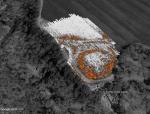Summary (English)
The work undertaken in 2018 and 2019 represents the end of a research cycle but is not the definitive end to the investigation of the rock-cut Hellenistic tomb of Grotte Scalina, dating to the last quarter of the 4th century B.C.
In 2018, a geophysical survey next to the tomb revealed a circular anomaly, about 40 m in diameter (Fig. 1). It may perhaps relate to the presence of a tumulus, similar to the arrangement presented by the coeval Torlonia Tomb in the necropolis of Monte Abatone at Cerveteri (Fig. 2). Given that the occupation of the two underground chambers seems to post-date their creation by at least a generation, it may be suggested that the first hypogean funerary space was excavated abutting the monument within the compact tufa layer – differing from the very friable layer present below the tomb – in which the façade was excavated, and later covered by a tumulus that further monumentalised the tomb. In 2019, in order to check this hypothesis, several sondages were opened in this area, which resulted as having been fortified in the medieval period (12th-13th century), and entirely subjected to land reclamation for agricultural purposes, down to the surface of the tufa bedrock, in the 1970s.All of the archaeological evidence, apart from that preserved in a wide curved ditch (Fig. 2), has been destroyed by the latter. In the medieval period, the walls of the site were built using small tufa blocks quarried at the site, and large blocks, some with mouldings (Fig. 3) that clearly date to the Etruscan period, thus confirming the existence of a construction contemporary with the tomb and built up against it. At present it cannot be determined whether it was quadrangular or circular in plan, or whether it was built to provide access to one of the original underground chambers in the complex. It is hoped to undertake a new geophysical survey in the future in order to check for the presence of man-made cavities, if present technology permits, in this sector of the funerary complex.
- Vincent Jolivet
Director
- Vincent Jolivet
Team
- Edwige Lovergne
Research Body
- CNRS
- ENS
Funding Body
- ARPAMED
- CNRS
- ENS






![Download [PDF]](/excavation/skins/fasti/images/results/download_sml.png)

